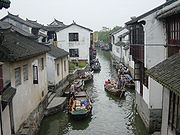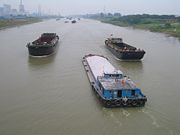 Town of Zhouzhuang, Jiangsu. South Jiangsu is famed for its towns crisscrossed by canals. | Jiangsu is very flat and low-lying, with plains covering 68 percent of its total area (water covers another 18 percent), and most of the province not more than fifty meters above sea level. Jiangsu is also laced with a well-developed irrigation system, which earned it (especially the southern half) the moniker of 水乡 (shuǐxiāng "land of water"); the southern city of Suzhou is so crisscrossed with canals that it has been dubbed "Venice of the East". The Grand Canal of China cuts through Jiangsu from north to south, traversing all the east-west river systems. Jiangsu also borders the Yellow Sea. The Yangtze River, the longest river of China, cuts through the province in the south and reaches the East China Sea. Mount Yuntai near the city of Lianyungang is the highest point in this province, with an altitude of 625 meters. Large lakes in Jiangsu include Lake Taihu (the largest), Lake Hongze, Lake Gaoyou, Lake Luoma, and Lake Yangcheng. |
| Historically, the river Huai He, a major river in central China and the traditional border between North China and South China, cut through north Jiangsu to reach the Yellow Sea. However, starting from 1194 AD, the Yellow River further to the north changed its course several times, running into the Huai He in north Jiangsu each time instead of its other usual path northwards into Bohai Bay. The silting caused by the Yellow River was so heavy that after its last episode of "hijacking" the Huai He ended in 1855, the Huai He was no longer able to go through its usual path into the sea. Instead it flooded, pooled up (thereby forming and enlarging Lake Hongze and Lake Gaoyou), and flowed southwards through the Grand Canal into the Yangtze. The old path of the Huai He is now marked by a series of irrigation channels, the most significant of which is the North Jiangsu Irrigation Main Channel, which channels a small amount of the water of the Huai He alongside south of its old path into the sea. On the Grand Canal near Yangzhou. | On the Grand Canal near |
| Jiangsu Province spans the warm-temperate/humid and subtropical/humid climate zones, and has clear-cut seasonal changes, with temperatures at an average of -2 to 4°C in January and 26 to 30°C in July. There are frequent rains between spring and summer (meiyu), typhoons with rainstorms in late summer and early autumn. The annual average rainfall is 800 to 1200 mm, concentrated mostly in summer when the southeast monsoon carries rainwater into the province |
| Major cities: | Nanjing | Suzhou | Wuxi | Changzhou | Zhenjiang |
| Yangzhou | Taizhou | Nantong | Lianyungang | Xuzhou | |
| Huaian | Yancheng | Suqian |
